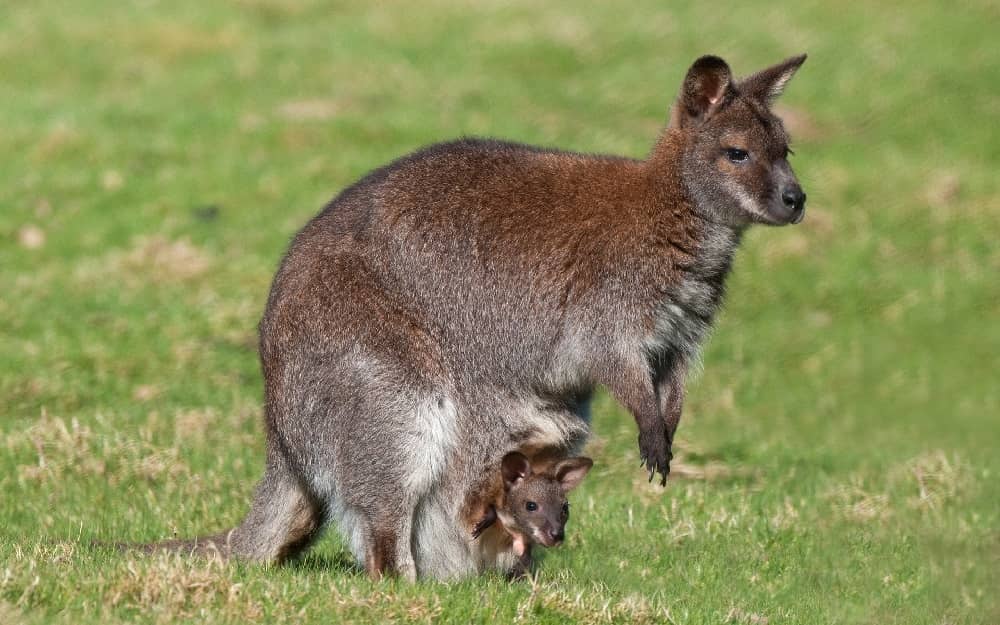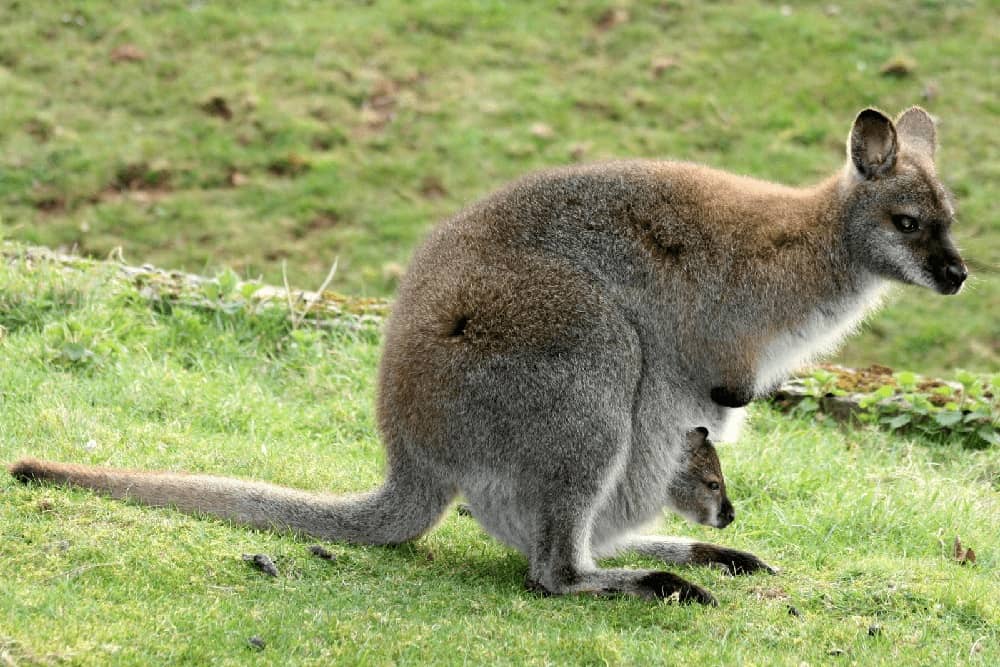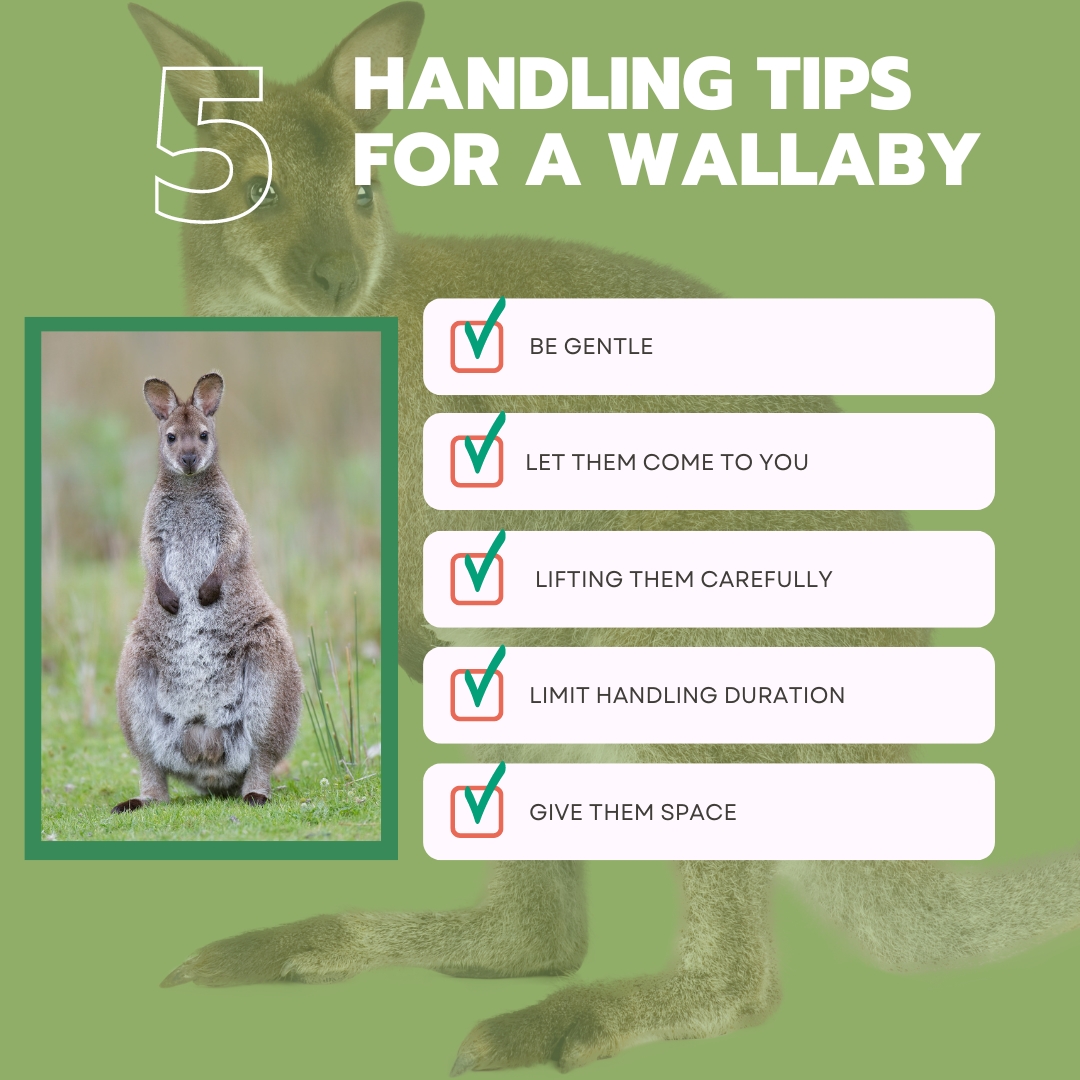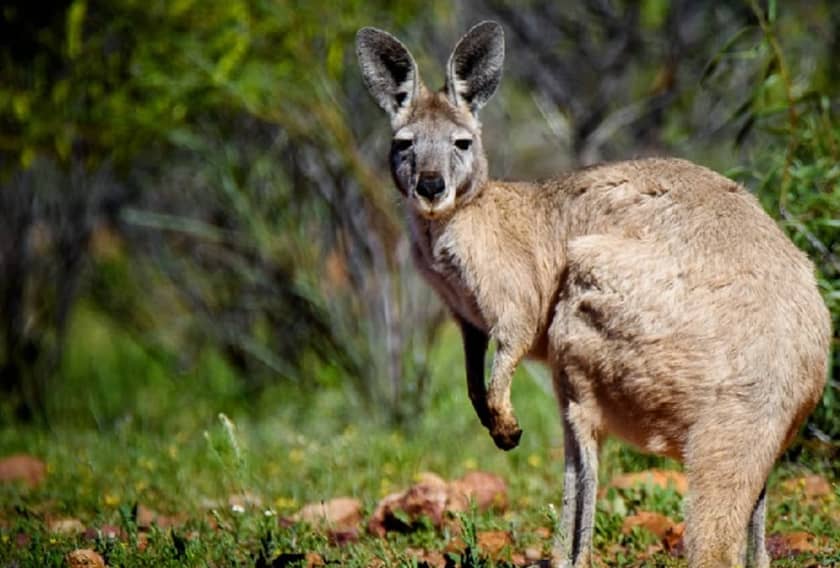A wallaby is a small to medium-sized marsupial native to Australia and nearby islands. They are closely related to kangaroos but are much smaller in size. They have large, flat teeth and elongated faces.

Wallabies have strong hind legs that help them hop around quickly, long tails for balance, and soft fur that can vary in color from gray to brown. They live in various habitats like forests, grasslands, and rocky areas. Wallabies are herbivores, meaning they eat plants, grass, and leaves. They are known for being shy and quiet animals, and many people find them cute and fascinating to observe.
Size information & Lifespan of Wallaby
Wallabies vary in size depending on the species. Most wallabies range between 18 to 42 inches in body length, with their tails adding another 12 to 28 inches. They typically weigh around 45 pounds.
As for lifespan, in the wild, wallabies generally live around 7 to 15 years and up to 15 years in captivity. Special Adaptations: The wallaby has a long, heavy tail to help them maintain their balance while hopping and for support when standing upright.
Behavior and Temperament of Wallaby
Wallabies are active and playful animals. You might see them doing things like punching, wrestling, and dancing. They can stand upright, grab things, and spar with each other. Wallaby travel by hopping, and red-necked wallabies can jump as high as 6 feet! When they move slowly, they use all four legs and their tail.

Many people say that female wallabies are sweeter and easier to handle than males, but the truth is that the differences are mostly about size and sex. Each wallaby has its personality, and how they interact with people depends a lot on their upbringing and experiences.
What does a Wallaby Eat or Drink?
Wallabies are herbivores, which means they eat plants. Their diet should mainly consist of fresh grasses, leafy greens, and vegetables like carrots, sweet potatoes, and spinach. You can also offer small amounts of fruits like apples or bananas as treats, but these should not be given in large quantities due to their sugar content.

For water, Wallaby needs a constant supply of fresh, clean water. Ensure they always have access to water, especially in warm weather, as staying hydrated is essential for their health. Use a shallow container that’s easy for them to drink from.
Enclosures for a Wallaby
While setting up an enclosure for a wallaby, you should consider some of the following points:
Space
Wallaby needs a large, open space to hop and move around freely. An outdoor enclosure of at least 50 square feet per wallaby is ideal. The space should allow them to exercise and explore comfortably.
Secure Fencing
The enclosure should have secure, high fencing (about 6-8) to prevent them from escaping. Ensure the fence is strong enough to withstand any attempts to jump or push against it.
Shelter
Wallabies need a sheltered area to protect them from extreme weather like rain, wind, or heat. You can provide a small shed or a roofed area with bedding like straw or soft blankets for warmth.
Shade
It’s important to ensure shaded areas within the enclosure to keep them cool in hot weather. Trees or a shade cloth can provide relief from the sun.
Bedding
Wallabies enjoy soft bedding materials such as straw or hay, which can be placed inside their shelter. This helps keep them warm, especially at night. The ground in the enclosure should be soft, ideally with grass, sand, or soil, as hard surfaces like concrete can harm their feet over time.
Grooming
Brushing
Wallabies have soft fur that can sometimes get dirty or matted. Regular brushing, especially after they’ve been outside, helps remove dirt and lose fur. Use a soft-bristle brush to avoid hurting their skin.
Nail Trimming
Just like other animals, a wallaby’s nails can grow long and sharp. It’s important to trim them regularly to prevent them from causing injury to themselves or others. A vet or professional can show you the correct way to trim their nails.
Bathing
Wallabies don’t usually need baths unless they get very dirty. If you do need to wash your wallaby, use warm water and mild, animal-friendly shampoo. Make sure to dry them off properly afterward.
Check for Ticks and Fleas
Regularly check their fur for ticks, fleas, or other parasites, especially if they spend time outdoors. Use vet-recommended flea treatment if needed.
Ear and Eye Cleaning
If you notice dirt or buildup, gently clean their ears and around their eyes with a soft, damp cloth.
Exercise
Wallaby needs plenty of space to hop around and exercise. They are very active animals that enjoy running, jumping, and hopping. A large fenced-outdoor area is ideal for them to move freely and stay healthy. Wallabies also like to explore their environment, so providing safe objects for them to interact with, like rocks or logs, can keep them entertained and active. Regular exercise helps them maintain strong muscles and a healthy weight.
The Health Issues of Wallaby
- Tetanus: Wallabies can get tetanus from bacteria that enter their bodies through wounds or cuts. This can cause muscle stiffness and difficulty breathing, but regular vaccinations can help prevent it.
- Toxoplasmosis: This is a disease caused by a parasite that can be found in contaminated food or water. It affects the immune system and can lead to serious health issues, especially in young or weak wallabies.
- Coccidioidomycosis(Valley Fever): This is a fungi infection that occurs in dry, dusty areas. It can cause coughing, fatigue, and weight loss. Wallabies in these areas need to be carefully monitored for symptoms.
- Salmonellosis: This bacterial infection comes from contaminated food or water. It can cause diarrhea vomiting, and dehydration. Clean and fresh food and water are essential to prevent this illness.
- Vitamin Deficiencies: Wallabies require a specific diet rich in fiber and nutrients. A [poor diet can lead to vitamin deficiencies, affecting their bones, muscles, and overall health. Ensuring they get a balanced diet with proper supplements is important.
List of Foods to Avoid for Wallaby
- Grains and Cereals
- Dairy products
- Sugary foods
- Chocolate
- High-Fat Foods
- Cabbage and cauliflower
- Avocado
- Citrus Fruits
- Rhubarb
Reproduction And Breeding
Mating season for most wallaby species happens in January and February. Females reach sexual maturity at around 12 Months old. The gestation period, which is the time before a baby is born, lasts about 28 days, though this can vary by species.
When a baby wallaby, called a joey, is born, it’s tiny, about the size of a jellybean. Only one joey is born at a time. Like kangaroo joeys, they are born helpless and not fully developed. Right after birth, they crawl into their mother’s pouch and latch onto a teat. Joeys stay in their mother’s pouch for about 2500 days. Even after they start exploring outside, They will jump back into the pouch if they sense danger.

Interestingly, a female wallaby can get pregnant again while a joey is still in her pouch. If this happens, the new embryo’s development is paused until the current joey leaves the pouch. This process called “embryonic diapause” is unique to marsupials like wallabies.
Wallabies typically live for about nine years. However, those living near human areas, where they might face predators like dogs and cats, often have shorter lifespans.
How to Handle a Wallaby?
Handling a wallaby needs to be done with care and patience. Wallabies are shy animals, and they can easily get scared, so knowing how to interact with them is very important.
Be Gentle
When you approach a wallaby, move slowly and quietly. Sudden movements or loud noises can frighten them. Wallabies are active mostly at night, so try to handle them when they’re more relaxed.
Let Them Come to you
Wallabies need to trust you. It’s better to sit quietly and allow the wallaby to come near you. You can offer them treats like fruits or vegetables, which can help them feel more comfortable around you.
Lifting Them Carefully
If you need to pick up a wallaby, make sure you support their whole body, including their back and bottom. Don’t pull on their legs or tail as this can hurt them. Hold them gently but securely.
Limit Handling Duration
Wallabies don’t like being handled too often. They prefer to move around freely in their space. Try not to pick them up too much, As it can stress them out.
Give Them Space
If the wallaby seems nervous, don’t push it. Let the wallaby have its space and come to you when it’s ready. This will help prevent the animal from getting upset or aggressive.

Wallaby Potty Training
Potty training a wallaby can be challenging, as they are not naturally suited for indoor environments like typical pets. To manage their bathroom habits, create a designated spot using grass or sand that’s easy to clean. Observe their behavior, and when you notice signs like sniffing or pacing, gently guide them to this area. Reward them with treats or praise when they use the spot correctly, reinforcing the behavior. Maintaining after meals can also help. However, accidents are likely, so it’s important to be patient and prepare for cleaning.
Where to Buy
Wallabies from breeders like Drangonstone Ranch, Which offers wallaby babies for adoption as well as care packages upon purchase. Additionally, other breeders typically have wallabies for sale, including male Bennetts wallabies. It’s recommended to check with USDA-licensed breeders for appropriate options and ensure all regulations are followed.
Interesting Facts About Wallaby
- The parma wallaby can become fertile again just a few days after giving birth, which means she can have another baby quickly.
- A female wallaby can become fertile again just a few days after giving birth, which means she can have another baby quickly.
- Baby wallabies are called “Joeys.” They stay in their mother’s pouch until they are big enough to explore.
- Like kangaroos, female wallabies have a pouch on their belly where the joey stays and grows after birth.
- The main predators of wallabies are foxes, wild cats, and dingoes (a wild dog from Australia)
- Wallabies have very strong hind legs that help them hop long distances, which is their main way of getting around.
- There are many different species of wallabies, and they can vary in size, color, and habitat.

Frequently Asked Question
Question: What does a wallaby eat?
Answer: Wallabies are herbivores and they mostly eat grass. They can also eat leaves, fruits, and other plants such as ferns and herbs.
Question: Where does Wallaby sleep?
Answer: Wallaby and kangaroos like to take short naps during the day and night. they prefer resting in safe spots that protect them from bad weather. However, they also enjoy lying on soft surfaces like sand or grass in open areas.
Question: How long do wallabies live as pets?
Answer: Wallabies can live for about 10 to 15 years as pets if they are well cared for.
Question: Can a wallaby bite?
Answer: Yes, Wallaby can bite if they feel threatened or scared. It’s important to handle them gently and give them space when they need it.
Question: What should you not feed a wallaby?
Answer: You should not feed wallabies any processed foods, dairy products, or sugary snacks. Avoid giving them citrus fruits and any food high in starch, like bread or potatoes, as it can upset their stomach.
Question: How can you care for a sick wallaby?
Answer: To care for a sick wallaby, keep it in a quiet, warm, and clean space. Provide fresh water and soft, easy-to-digest food. Monitor its behavior closely, and if symptoms worsen, contact a vet experienced with exotic animals. Follow any treatment and maintain hygiene to support recovery.
Question: What family does Wallaby belong to?
Answer: Wallaby belongs to the family Macropodidae.
Question: What are baby wallabies called?
Answer: Baby wallabies are known as joeys, just like baby kangaroos.
Conclusion
To take care of a wallaby, you need to provide a safe home, good food, and regular vet check-ups. Make sure they have enough space to move and play. Handle them gently so they feel safe and comfortable. With proper care, Wallabies can live healthy and happy lives.


